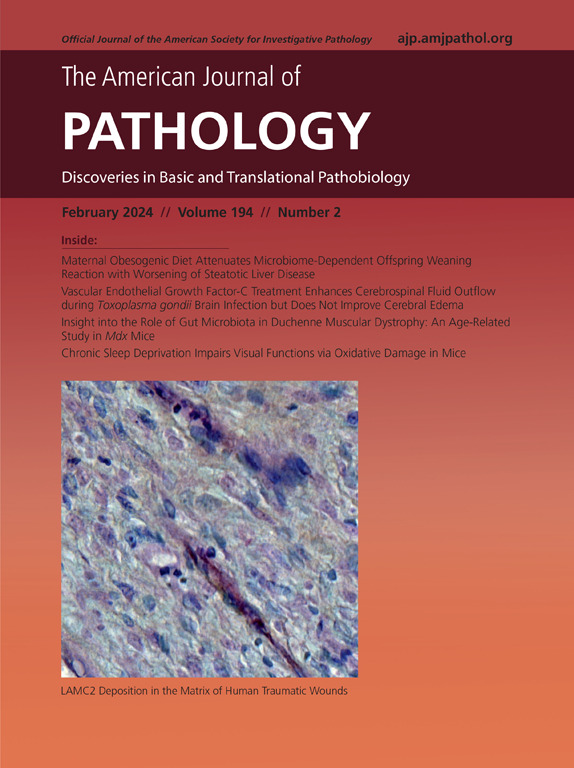胆管癌靶向治疗:作用机制和耐药性。
IF 4.7
2区 医学
Q1 PATHOLOGY
引用次数: 0
摘要
胆管癌是一种具有异质性基因组特征的侵袭性胆管恶性肿瘤。尽管大多数患者接受的是标准的化疗/免疫治疗,但现有或新出现的治疗方法可以靶向的基因组变化是很常见的。因此,精准医疗策略正在改变患者亚群的下一步治疗。热点IDH1突变和激活成纤维细胞生长因子受体2融合经常发生,针对这些改变的小分子抑制剂是美国食品和药物管理局批准的。转化和基础科学研究已经阐明了胆管癌的反应和耐药机制,为这些靶点扩展到其他癌症提供了见解。美国食品和药物管理局批准和国家综合癌症网络指南推荐的治疗复发性基因组变化的其他治疗方法包括BRAF抑制(BRAF- v600e)和曲司单抗德鲁德康(人表皮生长因子受体2扩增)。此外,正在进行的临床试验显示,KRAS抑制(KRAS密码子12突变)、PRTM5抑制(单独或与甲基硫代腺苷抑制(5-甲基硫代腺苷磷酸化酶缺失)和小鼠双分钟2抑制(小鼠双分钟2扩增)都有很好的结果。尽管取得了这些进展,但每种治疗的反应速度、深度和持续时间仍有待改进。此外,许多患者目前没有可靶向的基因型。在这篇综述中,我们基于患者样本和临床前模型的研究,研究了与这些治疗相关的临床疗效和耐药机制,以及通路激活和抑制的分子和生物学效应。我们还探讨了克服耐药性的策略和针对其他患者亚群的可能的精准医学方法。本文章由计算机程序翻译,如有差异,请以英文原文为准。
Cholangiocarcinoma Targeted Therapies
Cholangiocarcinoma is an aggressive bile duct malignancy with heterogeneous genomic features. Although most patients receive standard-of-care chemotherapy/immunotherapy, genomic changes that can be targeted with established or emerging therapeutics are common. Accordingly, precision medicine strategies are transforming the next-line treatment for patient subsets. Hotspot IDH1 mutations and activating fibroblast growth factor receptor 2 fusions occur frequently, and small-molecule inhibitors against these alterations are US Food and Drug Administration approved. Translational and basic science studies have elucidated the mechanisms of response and resistance in cholangiocarcinoma, providing insights into these targets that extend to other cancers. Additional US Food and Drug Administration–approved and National Comprehensive Cancer Network guideline-recommended treatments for recurrent genomic changes include BRAF inhibition (BRAF-V600E) and trastumazab deruxtecan (human epidermal growth factor receptor 2 amplification). Furthermore, ongoing clinical trials show promising results with KRAS inhibition (KRAS-codon 12 mutations), PRTM5 inhibition, alone or with methylthioadenosine inhibition (5-methylthioadenosine phosphorylase deletion), and murine double minute 2 inhibition (murine double minute 2 amplification). Despite these advances, the rate, depth, and duration of response to each treatment need improvement. Moreover, many patients do not have currently targetable genotypes. This review examines the clinical efficacy and mechanisms of resistance associated with these treatments, as well as insights into the molecular and biological effects of pathway activation and inhibition, based on study of patient samples and preclinical models. It also explores strategies to overcome resistance and possible precision medicine approaches for additional patient subsets.
求助全文
通过发布文献求助,成功后即可免费获取论文全文。
去求助
来源期刊
CiteScore
11.40
自引率
0.00%
发文量
178
审稿时长
30 days
期刊介绍:
The American Journal of Pathology, official journal of the American Society for Investigative Pathology, published by Elsevier, Inc., seeks high-quality original research reports, reviews, and commentaries related to the molecular and cellular basis of disease. The editors will consider basic, translational, and clinical investigations that directly address mechanisms of pathogenesis or provide a foundation for future mechanistic inquiries. Examples of such foundational investigations include data mining, identification of biomarkers, molecular pathology, and discovery research. Foundational studies that incorporate deep learning and artificial intelligence are also welcome. High priority is given to studies of human disease and relevant experimental models using molecular, cellular, and organismal approaches.

 求助内容:
求助内容: 应助结果提醒方式:
应助结果提醒方式:


